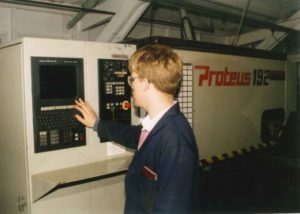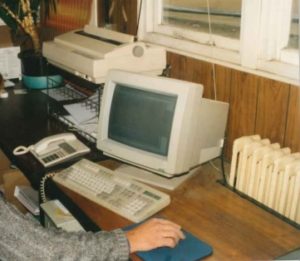GSM’s Digital Progression over 50 years
When GSM Graphic Arts began in 1974, the artworks we used to manufacture the labels and nameplates were hand drawn by our engineers as these were not expected to be used alongside digital machinery.
The digital revolution had a big impact on how we would continue to work and, as GSM invested in its first pieces of equipment that used PC’s to operate, it was noted that we needed to ‘digitalise’ our paperwork to ensure seamless use with the new machinery.
In the early 1990’s, GSM Graphic Arts invested in its first Wordprocessor computer which was used to aid the creation of artwork and technical drawings. In 1993, GSM invested in its first CNC punch press, a Proteus 192 which was used for punching metal labels out. See below a photograph of our current CEO, Paul Wright programming and using the machine in 1993.

The use of PC’s by our studio team meant that they were able to achieve so much more creatively than was previously possible. It was the beginning of the end of their trusty Letraset and camera but the use of digital artworks opened up so many more possibilities. Using computers and digital printing enabled our team to design labels to include photographic imagery and shading. At the time, this was extraordinary and a very exciting stage in the evolution of printing. This is the artistic version of the artwork that the customer sees and approves however there is whole other layer of ‘artwork’ that is needed to run the machines and manufacture the label which includes dimensions, cut paths and matrixes.
Moving into the noughties, GSM made one of our biggest technological advances and invested in a full CTS (computer to screen) suite that would help digitalise the creation of screens used when printing. This was a first for GSM Graphic Arts and one of the first in the UK. Once our designers have produced the artwork it is then loaded to the PC that runs the CTS machinery which uses UV light to expose and cure the design/image onto the emulsion on the mesh screen. Once the waste emulsion is removed, the screen is ready for printing.
We print the labels in sheet form, as this is the most economical way to manufacture them. Once they are printed, we use the ‘cut path’ file to load onto a computer to advise the machine of how and where to cut the labels. As we can laser cut both metal and plastic substrate, it is possible to cut the labels outer at the same time as cutting any holes that they may have using the digital laser machines that we operate. This saves time when manufacturing the products.
We are always looking to improve our manufacturing and continue to heavily invest in new technology and production methods to keep us at the forefront of labelling manufacturing.
GSM Graphic Arts has been manufacturing labels for nearly 50 years with the majority of this using digital equipment to aid our manufacturing.

